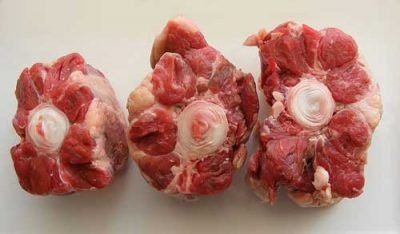
This was, of course, an April Fool’s joke. I apologize to the lady who wrote me a nasty letter this morning about being embarrassed by her butcher.
This is the first of a new, once-a-month series of articles about food ingredients. I hope you use the information to better understand some of the lesser-used but interesting ingredients available in Portland. I will always include suggestions as to uses along with the information.
Oxtail, occasionally spelled ox tail or ox-tail, is the culinary name for the tail of cattle. Don’t be confused – we are talking cows, not the oxen that were used to pull wagons along the Oregon Trail.
You’ll find oxtail on several Portland menus. Two that come to mind are the excellent oxtail croquettes at both Toro Bravo and Aviary. It is a bony, gelatin-rich meat, which is usually slow-cooked as a stew or braised.
If you are purchasing oxtail from your butcher, there are two things to keep in mind. First, oxtail has the meat-cutting classification NAMP 1791. You don’t need to know what that means, but if you mention it when you place your order, most butchers will look at you a bit differently. Second, oxtail is rated on a FLAT scale. As the tail is just above the anal gland, the type of flatulence (FLAT) generated as a result of the diet can have a large impact on taste. The national scale, which was last adjusted in 1993, is as follows:
FLAT 1 – Oxtail with this rating is the cheapest to find, but for good reason. These animals come from feed lots such as the one along Interstate 5 just south of San Francisco. The conditions are dirty and crowded, giving an abnormally high muskiness to the cut. This is the most strongly flavored oxtail – no surprise to anyone who has failed to roll up the car windows as they approach the feedlots. There is no question that these tails are from cattle with not only a high gas output, but also a fair amount of back-splatter. If you use them in a stew, it will be a dish you won’t soon forget! Occasionally, bottle fly larvae will be found in the meat, but they won’t hurt you, and your butcher will remove them. Use FLAT 1 tails to give stew an earthy, mushroomy, musky bite and serve with a big Cabernet Sauvignon.
FLAT 2 – These animals have been 100% corn-fed. As the kernels have plenty of time to ferment in the seven stomachs of a cow, you’ll find strong boozy notes, though when served in a stir fry with buttered corn, the combination is quite pleasant. I vaguely remember a local restaurant using them in a vanilla ice cream (Aviary?) – a clever play on rocky road. I’ve used these when doing a barbecue for my family, where the food wasn’t the focus. Serve it with a nice Pouilly-Fuissé.
FLAT 3 – is raised on grass and finished on corn and grains. Though it generally has slightly more barnyard-like characteristics than the prized FLAT 4, this is my favorite oxtail. The combination of gases from three different diet sources makes the flavors nice and balanced. Try it for fried foods such as the croquettes mentioned above, or even something more out of the box, such as using a tail tip as a Twinkie stuffing. One of my favorite lunches is tail tips laid in a crosshatch pattern in a peanut butter sandwich.
FLAT 4 – raised on nothing but billowing green grass, this is the Caspian caviar of oxtail. The flavor is mild and grassy, making it a perfect accompaniment to salad greens and dishes with plenty of good olive oil. Within the rating is FLAT 4a and FLAT 4b, the first being the most delicate as it is exposed to anal discharges/splatter-back for the shortest period of time – call it the “veal of oxtail”. 4b cuts are slightly more loamy in flavor, and pair wonderfully with light mushroom dishes, or even on a nicely crisped bruschetta topped with grassy olive oil and lots of garlic.
Although traditional preparations often involve hours of slow cooking, modern methods usually take a shortcut by utilizing a pressure cooker. Oxtail is the main ingredient of the Italian dish coda alla vaccinara. It is a popular flavour for powder, instant, and premade canned soups in the United Kingdom and Ireland. Oxtails are also one of the popular bases for Russian aspic appetizer dishes (холодец or студень), along with pig trotters or ears or cow “knees”, but are the preferred ingredients among Russian Jews because they can be Kosher.
Oxtail is easy to prepare and a bargain-priced meat. Don’t be afraid to ask your butcher for “a little tail!” He’ll be glad someone is taking an interest.
Jill-O says
FLAT ratings?! HAHAHAHAHA!! Good one!
Happy April 1st to you to FD…always a fun post every year!
Good on ya!
PDX Food Dude says
Why thank you. A little part of me is secretly hoping someone goes to the butcher and asks for an oxtail with a FLAT rating of 4 ;>)
PDX2FLR says
You’ve done it now. My butcher always recommends the Flat 4b (you know who you are you devil)!
Susan@SkyBLue Portland says
I may never eat oxtail again. :-)